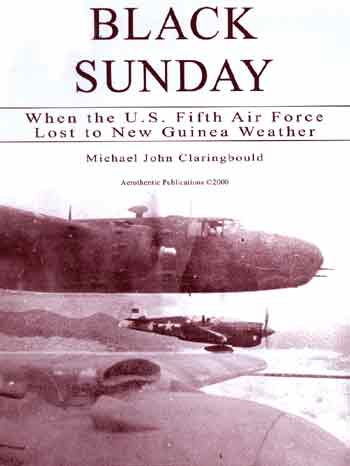|
|
|
|
| Missing In Action (MIA) | Prisoners Of War (POW) | Unexploded Ordnance (UXO) |
| Chronology | Locations | Aircraft | Ships | Submit Info | How You Can Help | Donate |
|
 by Michael Claringbould Aerothentic 2000 Softcover 120 pages Index, photos, maps, appendix Cover Price: $27.65 Language: English via Pacific Ghosts Return to |
Black Sunday When The US Fifth Air Force Lost To New Guinea's Weather Not only is Black Sunday fine work, it is also cutting-edge research, and intriguing reading. The challenging task he has completed in this book is to explain how thirty-seven aircraft came to be destroyed or lost in one afternoon by a New Guinea weather front. The story of April 16, 1944 "Black Sunday" is truly harrowing story about hundreds of aircraft being forced to fly though a severe and unexpected weather front that blocked their path home. Many crashed, unfamiliar with purely instrument flying. Others ran low on fuel and crashed into thick jungle, mountains, or the water of Papua New Guinea's Madang Province. Most of the losses were A-20's which were already pushing their fuel capabilities flying to Hollandia. Caught behind enemy lines, returning squadrons of returning US Fifth Force aircraft had no choice but to take on the front. Many are still missing, and many forced-landed rather than take on the weather. Some crew members escaped, whilst others did not. Flown on April 16, 1944 from Nadzab in New Guinea's Markham Valley, Black Sunday represents the largest weather-related loss in aviation history, yet ironically not one aircraft was lost to the Japanese. Michael Claringbould spent eight years researching, documenting and interviewing survivors from the day's events. Six appendices, and scores of first-class never-before published photos complement the latest edition of this book. Aside from a absolutely superb historical retelling of the event, the book goes one step further. Each Black Sunday loss is documented, including the whereabouts of each wreck. The fact that some of the planes where not discovered until the 1980's or 1990's is testament to the harsh and isolated terrain of New Guinea. Today, there are still 10 planes MIA from the day. There are six appendix sections full of photographs, MIA list, aircraft descriptions, serial numbers and maps. After completing the book, one can't help but think how difficult it was to fight, let alone fly in New Guinea, especially with primitive aircraft and navigation tools. Bailing out or ditching offered no certainty either. The Japanese would behead captives, and airmen would die of exposure if lost in the jungle. The story of Black Sunday is truly incredible, and the author presents the information with meticulous accuracy and attention to detail: compiling research, oral history, and official records and diaries. He avoids constant reference to unit numbers and abbreviations and instead writes in a way that reads like a war novel, instead of nonfiction! The historical detail is outstanding, and it is compulsory reading for anybody remotely interested in the war in New Guinea, the eternal battle of man versus the elements, or those with interest in the misadventures of Pacific B-24 Liberators, A-20s, P-38 Lightnings or B-25 Mitchells. I recommend Black Sunday as one of the finest books produced to date on the Pacific War. Interview with author Michael Claringbould Review by Justin Taylan Return to Book Reviews | Add a review or submit for review |
| Discussion Forum | Daily Updates | Reviews | Museums | Interviews & Oral Histories |
|